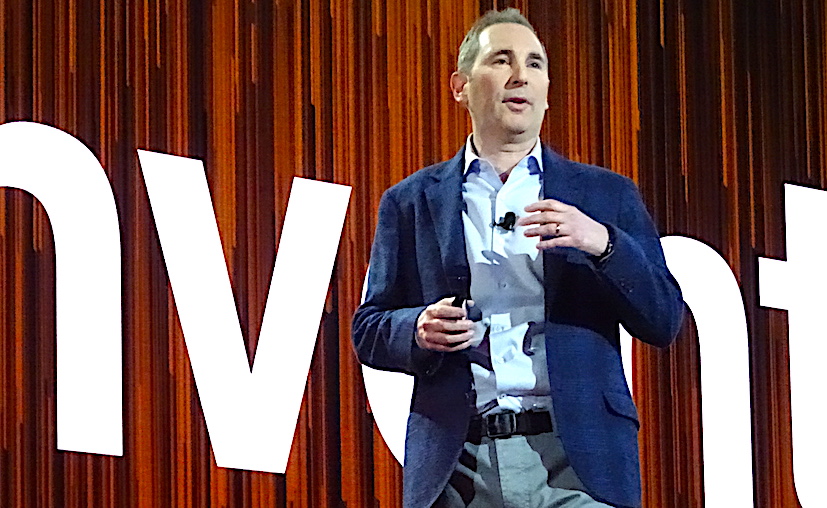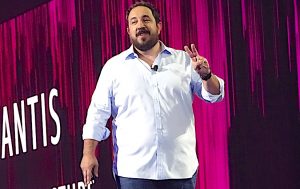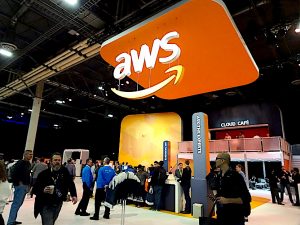 CLOUD
CLOUD
 CLOUD
CLOUD
 CLOUD
CLOUD
Amazon Web Services Inc. came into its sixth annual re:Invent conference in Las Vegas with a fairly dominant lead in the foundational cloud computing services that are sweeping across the information technology industry.
If anything, Amazon.com Inc.’s cloud unit exited the five-day show, which ended Friday, looking even stronger. More than that, AWS Chief Executive Andy Jassy (pictured) made the case that his company isn’t just providing base-level computing, storage and networking services anymore. It’s moving up the software “stack” to provide artificial intelligence, database, virtual and augmented reality, video production and other services.
SiliconANGLE and its livestreaming studio theCUBE provided wall-to-wall coverage of re:Invent 2017, which attracted more than 42,000 software developers, customers, partners, analysts and press to Las Vegas to hear about nearly two dozen new services from AWS as well as dozens more from partners and customers. Here’s a summary of that coverage:
SiliconANGLE co-CEO John Furrier kicked off coverage with an exclusive, three-part interview with Jassy, who previewed in broad outline what AWS would reveal at re:Invent:
“It’s kind of wacky these days to build a data center,” Jassy said in laying out how he views the cloud’s next land grab, for enterprise information technology departments. “While I still characterize it as the early days of adoption, make no mistake: Enterprises are not just dabbling in the cloud. They are using AWS and the cloud in a very pervasive way.”
Nobody likes the misleading name of the latest hot trend in cloud technologies, but “serverless” computing nonetheless has captured the hearts and minds of an increasing number of companies looking for an easier onramp into cloud computing. Serverless refers to an emerging way of creating cloud applications that doesn’t require software developers to fuss with provisioning servers and storage in the cloud. It doesn’t actually get rid of servers, but cloud providers such as Amazon Web Services Inc. take care of the heavy infrastructure lifting, potentially saving time and money spent on excess cloud computing and storage. Jassy spoke about AWS’s plans to move more forcefully to provide serverless technologies through its Lambda and other services. “The torrid pace of adoption and innovation in the serverless space has totally blown us away,” he said, with hundreds of thousands of users, more than four times as many as a year ago.
Jassy talked about how Amazon identifies and settles on which new products and markets to pursue. High on the list: China, where it recently sold more than $300 million worth of data center assets to its Chinese partner and faces a formidable foe in Alibaba Group Holding Ltd. Jassy revealed that Amazon plans to open its biggest cloud region in China in the next few months to pursue its growth strategy in the huge market against the odds. In another sense, however, AWS is staying put — that is, inside Amazon. Countering speculation that the retail giant could spin off AWS, which of course is a very different business from Amazon’s core, Jassy explained why it’s not in the cards anytime soon.
SiliconANGLE’s livestreaming studio theCUBE was on hand for three solid days of coverage, starting off with an analysis of the competitive landscape, which remains sparse:
“I reckon the competitors to Amazon are actually distancing themselves from AWS,” said co-host Justin Warren. “They’re trying to find their own way of doing things, because you can’t out-AWS AWS.” But there are really just two competitors, added guest host Keith Townsend. In talks with Fortune 500 companies, he said, “when they describe what they want, they’re describing AWS, Azure and Google Cloud and everything else is just not even part of the discussion.”
AWS itself kicked off the conference early with some announcements early Nov. 28 on at least two new expansions of its cloud services:
Immersive technologies such as virtual reality and augmented reality could soon become much more commonplace thanks to AWS’s launch early Monday morning of a new development platform. The public cloud computing giant took the wraps off its new Amazon Sumerian service, which provides a platform for developers to create realistic virtual environments that can be populated with animated characters and other 3D objects.
AWS stepped up its video production capabilities as it bids to become the platform of choice for companies focused on creating video-based content. The company announced early Monday that it’s expanding the scope of its popular AWS Elemental Media Services suite with five new services designed to enable the end-to-end processing of video content.
The company did its customary geek-out keynote Tuesday evening, as Peter DeSantis (pictured below), vice president of AWS Global Infrastructure, introduced a bare-metal computing service to keep pace with rivals Oracle Corp. and IBM Corp.:
 Looking to keep ahead of rivals in cloud computing, AWS late Tuesday announced so-called “bare-metal” server instances that provide customers with direct access to raw computing power. Its first bare metal server instances are part of its i3 instance family in a public preview, but Amazon said it expects to expand them to other instance families in coming months. These instances have no software pre-installed on them, so customers can use all the computing resources and also quickly configure them and change that configuration as they choose.
Looking to keep ahead of rivals in cloud computing, AWS late Tuesday announced so-called “bare-metal” server instances that provide customers with direct access to raw computing power. Its first bare metal server instances are part of its i3 instance family in a public preview, but Amazon said it expects to expand them to other instance families in coming months. These instances have no software pre-installed on them, so customers can use all the computing resources and also quickly configure them and change that configuration as they choose.
During the week, Amazon sought to emphasize that it’s winning more and more large enterprises, unveiling a raft of new and expanded customers in a variety of industries that are going all-in on AWS with some of their core operations:
AWS revealed that it’s adding four more major enterprise customers to its cloud platform, following a similar deal with the media company Turner Broadcasting System Inc. Amazon said it had landed deals with The Walt Disney Co., online travel firm Expedia Inc., the National Football League and financial management software provider Intuit Inc. to move some of their IT infrastructure to its cloud, and to take advantage of its artificial intelligence and machine learning services.
Amazon also strengthened some of its partner relationships, including a key one inked last year with VMware Inc.:
Longtime rivals VMware and AWS are looking even chummier these days as the companies expand their landmark partnership announced last year to make it easier for VMware customers to move their workloads easily to the Amazon cloud. The companies announced a new migration product that they said makes it possible for enterprises to shift workloads to the cloud with zero downtime and the option to continue using the management and monitoring tools they’re accustomed to on-premises.
But the centerpiece of the show was Andy Jassy’s keynote on Wednesday morning, when he made the case for a simpler cloud that can be accessed by many more organizations and the people in them:
Cloud computing was supposed to make corporate information technology a lot simpler, and in many ways it has — but as the cloud itself has exploded, so too has the complexity of managing all the pieces. That’s the problem Jassy signaled that AWS is attacking in force. In a wide-ranging series of 22 new services for tackling everything from storing data to analyzing it to employing machine learning, it was apparent that the company hopes to make the technologies easier and more accessible to a larger number of software developers.
Analysts noticed that Jassy is aiming at particular rivals, especially Oracle:
Although Amazon Web Services Inc. has made plenty of news this week with a multitude of headline-grabbing announcements, much of the talk has surrounded Jassy’s pointed remarks on Wednesday about competitors such as Oracle Corp. “He’ll only talk trash if he’s got a solution in his back pocket,” said theCUBE co-host John Furrier in an analyst with Wikibon analyst Stu Miniman of Jassy’s Nov. 29 keynote. “He called them an abusive partner to their customer. That’s a line in the sand; those are fighting words.”
Jassy also appeared on theCUBE, providing his own takeaways and thoughts on what’s coming next:
“In the very early days of AWS, Jeff used to say, ‘If I was building Amazon today, I would have built it on top of AWS,’” said Jassy. “He knew what was coming, and he saw what people were still able to accomplish even with where the services were at that point.” Not only would Amazon have been built on AWS, Jassy said, it would have taken full advantage of serverless computing. The computing model, where the cloud provider does all the managing of machine resources and users pay only for what they need, has grown to become a significant part of AWS’s business.
In his keynote, Jassy also introduced a surprise hardware product that’s intended to make it easier to create deep learning neural network models:
Amazon wants to give developers hands-on deep learning experience with its latest hardware, DeepLens, a wireless camera that developers can use to run deep learning and image recognition models. A collaboration between AWS and Intel Corp., it provides developers of all skill levels with the necessary tools to create artificial intelligence and machine learning products.
To top things off, the company weighed in with new database services, increasingly a nexus of competition in the cloud:
The company on Wednesday introduced a new offering called Aurora Serverless that aims to boost the reliability, scale and usability of its Aurora database. In addition, it announced a brand-new service called AWS Neptune to help customers build and run graph databases.
Amazon slipped in a few more product enhancements as well, including services around application containers:
Following in the footsteps of public cloud rivals Google LLC and Microsoft Corp. for once, AWS on Wednesday finally announced it’s supporting the open-source Kubernetes container orchestration engine. The company also introduced a new managed service called Fargate for running containers without worrying about the underlying servers or clusters.
 The company added new features to its AWS Marketplace and expanded its AWS Partner Network and AWS Competency Program. The company also found time to roll out a new service called AWS PrivateLink, which allows allows software-as-a-service application developers who build on AWS to offer private endpoints as an additional option for accessing their service.
The company added new features to its AWS Marketplace and expanded its AWS Partner Network and AWS Competency Program. The company also found time to roll out a new service called AWS PrivateLink, which allows allows software-as-a-service application developers who build on AWS to offer private endpoints as an additional option for accessing their service.
Not least, Amazon Chief Technology Officer Werner Vogels, in his much-anticipated annual keynote Thursday morning, not only unveiled a new set of business services based on its Alexa digital assistant, but also suggested it’s the dawn of a new era of human-centered interfaces in IT:
Alexa is headed to the office. Her job: reinventing information technology at every business. Amazon.com Inc.’s cloud computing unit announced that its voice assistant, currently residing mostly on its Echo line of smart speakers in people’s kitchens and living rooms, will be coming to business offices. Alexa for Business is intended to be used in conference rooms and other office settings, and Amazon’s hope is that they will usher in a new round of business-oriented applications that use voice as the key interface. “The interfaces of the future will be human-centered,” Vogels said during his Nov. 30 keynote. “Voice represents the next major disruption in computing.”
Vogels’ keynote made it clear that Amazon is taking a broader view of the entire information technology ecosystem, building an impressive lead over the biggest players in the technology industry. “They are becoming the lever, the catalyst for [information technology] transformation,” said Furrier. “IT and Amazon have come together in a massive collision and there’s going to be carnage.”
Analysts on theCUBE wrapped up the show with a view that AWS will be hard to beat because of its combination of scale and speed:
There are plenty of technology companies with hefty revenue, tens of thousands of employees and a sizable global customer base. There are also smaller, nimble firms with modest profits that can innovate fast and keep larger competitors scrambling to keep up. And then there is that rarely seen third category that combines size, massive revenue and dizzyingly fast innovation. Welcome to Amazon Web Services Inc. “Amazon is not only the 800-pound gorilla, but they are the cheetah in the marketplace, because they move faster,” said Stu Miniman, senior analyst with Wikibon, in an analysis on theCUBE to wrap up the conference:
Finally, Wikibon’s Jim Kobielus summed up the massive number of announcements at the show and their implications for AWS and the entire IT industry:
AWS discussed how it differentiates through deepening investments in its core infrastructure-as-a-service and cloud database offerings. Going forward, the company made it clear that it intends to stoke ongoing growth through strategic investments in game-changers such as artificial intelligence, streaming media and the “internet of things.”
For more in-depth color commentary from AWS, its partners, customers, the venture capital community and analysts, check out more interviews on theCUBE from re:Invent 2017.
Support our open free content by sharing and engaging with our content and community.
Where Technology Leaders Connect, Share Intelligence & Create Opportunities
SiliconANGLE Media is a recognized leader in digital media innovation serving innovative audiences and brands, bringing together cutting-edge technology, influential content, strategic insights and real-time audience engagement. As the parent company of SiliconANGLE, theCUBE Network, theCUBE Research, CUBE365, theCUBE AI and theCUBE SuperStudios — such as those established in Silicon Valley and the New York Stock Exchange (NYSE) — SiliconANGLE Media operates at the intersection of media, technology, and AI. .
Founded by tech visionaries John Furrier and Dave Vellante, SiliconANGLE Media has built a powerful ecosystem of industry-leading digital media brands, with a reach of 15+ million elite tech professionals. The company’s new, proprietary theCUBE AI Video cloud is breaking ground in audience interaction, leveraging theCUBEai.com neural network to help technology companies make data-driven decisions and stay at the forefront of industry conversations.